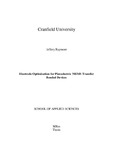JavaScript is disabled for your browser. Some features of this site may not work without it.
| dc.contributor.advisor | Kirby, Paul B. | |
| dc.contributor.author | Raymont, Jeffery | |
| dc.date.accessioned | 2011-11-10T14:55:43Z | |
| dc.date.available | 2011-11-10T14:55:43Z | |
| dc.date.issued | 2008-09 | |
| dc.identifier.uri | http://dspace.lib.cranfield.ac.uk/handle/1826/6579 | |
| dc.description.abstract | Optimisation can be viewed in many ways including that which is new and improvements to the materials, or methods that are already in place. Therefore we can define the two specific areas that make up the investigation relating to this work; those pertaining to new materials which may improve performance, and an analysis of the methods, and results, with regard to adhesion of the dissimilar materials incumbent in the present structures. In this work, two candidate materials have been identified in order to improve the performance of the electrode structures present in MEMS devices used for piezoelectric applications. These are the conductive oxides, Lanthanum Nickel Oxide and Ruthenium Oxide, which have shown considerable promise because of their reported improvements in fatigue properties with PZT applications. They have been investigated as potential top layer electrodes as the literature has indicated that substantive improvements can be made in piezoelectric performance when conductive oxides are used as a top electrode. The results for LNO as a top electrode using deposition through CSD yielded no crystalline presence when examined with XRD. However, the results indicate a possible amorphous presence when subjected to a strict cleaning regime and crystallisation using rapid thermal annealing. LNO deposition through CSD, when used as a top electrode with PZT has not been previously reported. This warrants further investigation as a basis for future work. Conductive ruthenium oxide has been deposited through sputtering using a ruthenium target source and an 80/20 argon/oxygen mix. The results for ruthenium oxide deposited on to glass slides indicate that resistivity improves with annealing temperature. The results indicate successful ruthenium deposition on to PZT 30/70 but have produced mixed results when subjected to annealing because of the thickness of the ruthenium oxide deposited. Two methods for measuring adhesion have been evaluated for their suitability in relation to thin metal films. The multi pass wear scratch test proved unsuitable for producing meaningful results with films deposited on to PZT. The pull test produced some results which mean that comparative analyses are possible for the thin film systems making up the electrode structure. The stressed overlayer technique has been used as a means to evaluate the work of fracture for the metal electrodes making up the present structure. A model has been used on the blister structures resulting from the stressed overlayer. In addition, the method has enabled qualitative judgments of the electrode structures submitted for analysis. | en_UK |
| dc.language.iso | en | en_UK |
| dc.publisher | Cranfield University | en_UK |
| dc.rights | © Cranfield University, 2008. All rights reserved. No part of this publication may be reproduced without the written permission of the copyright holder. | en_UK |
| dc.subject | PZT | en_UK |
| dc.subject | Adhesion | en_UK |
| dc.subject | Pull Testing | en_UK |
| dc.subject | Conductive Oxides | en_UK |
| dc.subject | LNO | en_UK |
| dc.subject | RuO2 | en_UK |
| dc.subject | Stressed Overlayer | en_UK |
| dc.title | Electrode optimisation for piezoelectric MEMS transfer bonded devices | en_UK |
| dc.type | Thesis or dissertation | en_UK |
| dc.type.qualificationlevel | Masters | en_UK |
| dc.type.qualificationname | MSc by Research | en_UK |
